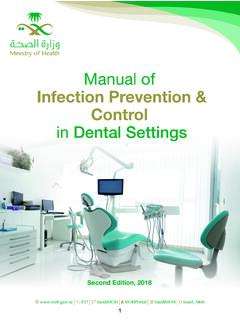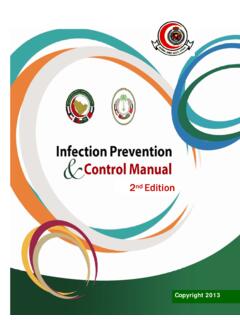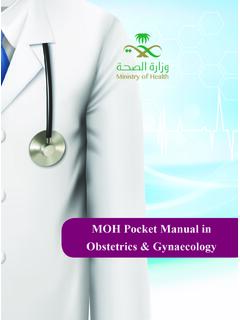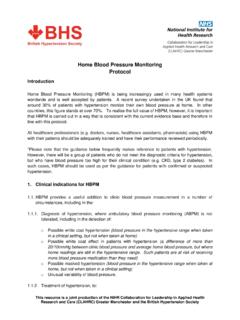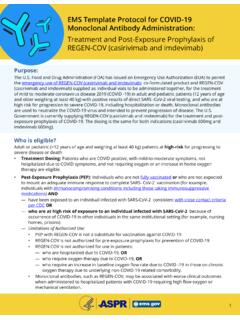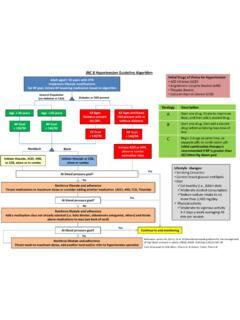Transcription of Saudi MoH Protocol for Patients Suspected of/Confirmed ...
1 Saudi MoH Protocol for Patients Suspected of/ confirmed with COVID-19 Supportive care and antiviral treatment of Suspected or confirmed COVID-19 infection (Version ) January 13th, 2022 1 Disclaimer: This is a living guidance that is subject to change as more evidence accumulates. It will be updated regularly and whenever needed. The guidance should be used to assist healthcare practitioners select the best available pharmacotherapy for COVID-19 infection according the best available and current evidence and is not intended to replace clinical judgement but rather to complement it. The evidence is inconclusive regarding the efficacy of most medications for covid-19. It is important to explain this to patient and family and obtain informed consent for use of these medications for unapproved indications. Convalescent plasma transfusion should only be used according to an approved study Protocol COVID-19 Testing* Category Supportive Care Pharmacotherapy Precautions Suspicious Cases (follow case definition published in Saudi CDC guidelines) Mild to Moderate: Symptoms with no shortness of breath - Treat symptoms - If no hospital admission required, need to follow instructions and recommendations published by Saudi CDC - Not required - Do not stop ACEI/ARBs in Patients with hypertension, post-MI, or heart failure - Paracetamol (acetaminophen) is the prefered agent for pain/fever see below table Medication Related Information - Labs and work-up: CBC, Urea/Electrolytes, Creatinine, CRP, LFTs, Chest X-ray, COVID-19 PCR tests Mild to Moderate.
2 Symptoms with no shortness of breath in high-risk Patients $ - Treat symptoms - If hospital admission is not required, follow instructions and recommendations published by Saudi CDC - Consult Infectious Disease Specialist - Case shall be discussed with infectious disease specialist, to initiate empirical antiviral therapy, while awaiting PCR result. - Do not stop ACEI/ARBs in Patients with hypertension, post-MI, heart failure If decision is to treat empirically, follow the treatment option under confirmed by PCR Mild to Moderate: Symptoms with shortness of breath in high-risk Patients $ PCR confirmed Cases Asymptomatic - Follow instructions and recommendations published by Saudi CDC - Not required Saudi MoH Protocol for Patients Suspected of/ confirmed with COVID-19 Supportive care and antiviral treatment of Suspected or confirmed COVID-19 infection (Version ) January 13th, 2022 2 COVID-19 Testing* Category Supportive Care Pharmacotherapy Precautions PCR confirmed Cases Mild to Moderate.
3 Symptoms (no O2 requirements/no evidence of pneumonia but with other symptoms of covid-19 , fever) - Inclusion criteria for using oral antiviral: 1. Aged 12 years, weighing at least 40 kg (for paxlovid) and >18 years (for molnupiravir) 2. At high risk for progression to severe COVID-19 ( , hospitalization or death) 3. Within 5 days of symptoms onset - Exclusion criteria for using oral antiviral 1. Age < 12 years (for paxlovid) and <18 years (for molnupiravir) 2. Weighing < 40 kg (for paxlovid) 3. History or current need for hospitalization/immediate medical attention in a clinic/emergency room service due to COVID 4. Not to be used for more that 5 days - Inclusion criteria for using Anti-SARS-CoV-2 Monoclonal Antibodies should only be used in Patients with high risk for progression to severe COVID-19 and/or hospitalization.
4 These include: 1. confirmed documented positive PCR < 3 days prior to Day 1 2. Within 7 days of symptom onset 3. > 1 of signs and symptoms of COVID-19 within 24 hours prior Day 1 4. > 1 of following risk factors: Aged 65 years, obesity (BMI >35), end-stage renal failure, sickle cell anemia, immunocompromising condition (or chronic immunosuppressive treatment ), and/or age 55 65 years ( with cardiovascular disease, hypertension, diabetes, or COPD). 5. Blood oxygen saturation > 92% obtained at rest by attending physician within 24 hours prior Day - Exclusion criteria for using Anti-SARS-CoV-2 Monoclonal Antibodies: 1. Age < 18 years - Treat symptoms - Follow instructions and recommendations published by Saudi CDC In case of new onset cough and fever or anosmia, or both) within 7 days - Consider inhaled budesonide (Pulmicort ) o Adult Dosing: 800 g per actuation (two inhalations) twice a day until symptom resolution For non-hospitalized Patients at high risk of disease progression (When available) - Consider ritonavir-boosted nirmatrelvir (Paxlovid) o 12 years and weighing 40 kg: nirmatrelvir 300 mg plus ritonavir 100 mg (oral) twice daily for 5 days.
5 OR - Molnupiravir o >18 years: 800 mg every 12 hours for 5 days For non-hospitalized Patients at high risk of clinical progression treatment (When available): - Consider sotrovimab o 12 years and weighing 40 kg: 500 mg intravenous IV infusion once. Inhaled budesonide (Pulmicort ) see below table Medication Related Information - Bronchospasm, oral candidiasis, and vasculitis Sotrovimab (non-formulary and non-SFDA registered) see below table Medication Related Information - May cause infusion-related reactions, hypersensitivity/anaphylaxis during infusion and for 1 hour following infusion completion Ritonavir and Nirmatrelvir (non-formulary and non-SFDA registered) see below table Medication Related Information - Patients treated with Ritonavir and Nirmatrelvir are at risk of hepatic effects and renal impairment - Patients on other ritonavir- or cobicistat-containing regimens, with HIV or hepatitis C virus taking ritonavir- or cobicistat-containing regimens should continue those regimens as indicated - Risk of HIV-1 protease inhibitor drug resistance Molnupiravir (non-formulary and non-SFDA registered) see below table Medication Related Information - Bone and cartilage toxicity was observed in animals after repeat dosing Anticoagulation see below Thromboprophylaxis Saudi MoH Protocol for Patients Suspected of/ confirmed with COVID-19 Supportive care and antiviral treatment of Suspected or confirmed COVID-19 infection (Version )
6 January 13th, 2022 3 COVID-19 Testing* Category Supportive Care Pharmacotherapy Precautions PCR confirmed Cases 2. History or current need for hospitalization/immediate medical attention in a clinic/emergency room service due to COVID 3. Receipt of COVID-19 vaccination any prior time 4. Received convalescent plasma treatment at any prior time 5. Receipt of systemic steroid or inhaled steroid within 30 days, unless a stable dose is used for chronic condition 6. Pregnant or breastfeeding females 7. Previous hypersensitivity, infusion related reaction, or adverse reaction to any monoclonal antibodies Severe: Clinical signs of pneumonia (fever, cough, dyspnea, fast breathing) and one of the following: - Respiratory rate >30/min (adults); 40/min (children < 5 years) - Blood oxygen saturation <90% on room air - Severe respiratory distress - Treat symptoms - Follow instructions and recommendations published by Saudi CDC - ICU admission, decision by ICU treating team - Antibiotics and antifungals according to local antibiogram and institutional pneumonia management guidelines/ pathways.
7 Systemic Corticosteroids use: For all Patients who require supplemental oxygen inlcuding (but not limited to) those requiring non-invasive and invasive ventilation. To be used up to 10 days, until discharged, or if patient becomes asymptomatic. Dexamethasone (Preferable Systemic Corticosteroids): o Adult Dosing: 6 12 mg once daily oral (liquid or tablet) or intravenous preparation. Patients on chronic steroids, follow the usual recommendation of doubling steroids dose or start stress dose steroids based on clinical case basis on Patients condition OR Prednisolone/ Prednisone o Adult Dosing: In pregnant or breastfeeding women, prednisolone/ Prednisone 40 mg PO twice daily should be used instead of dexamethasone. o Pediatric Dosing: Prednisolone/ Prednisone (Oral/NG): 1 mg/kg once daily (max: 40 mg) OR Hydrocortisone o Adult Dosing: In pregnant or breastfeeding women that cannot take oral, IV hydrocortisone 80 mg twice daily should be used instead of dexamethasone.
8 O Preterm infants with a corrected gestation age of <40 weeks: mg/kg every 12 hours OR Methylprednisolone sodium succinate (IV): mg/kg once daily (max: 32 mg) Systemic Dexamethasone see below table Medication Related Information - Cardiovascular disease: Use with caution in Patients with heart failure and/or hypertension; use has been associated with fluid retention, electrolyte disturbances, and hypertension. Use with caution following acute myocardial infarction; corticosteroids have been associated with myocardial rupture. - Diabetes: Use corticosteroids with caution in Patients with diabetes mellitus; may alter glucose production/regulation leading to hyperglycemia. - Gastrointestinal disease: Use with caution in Patients with GI diseases (diverticulitis, fresh intestinal anastomoses, active or latent peptic ulcer, ulcerative colitis, abscess or other pyogenic infection) due to perforation risk.
9 - Myasthenia gravis: Use with caution in Patients with myasthenia gravis; exacerbation of symptoms has occurred especially during initial treatment with corticosteroids. Saudi MoH Protocol for Patients Suspected of/ confirmed with COVID-19 Supportive care and antiviral treatment of Suspected or confirmed COVID-19 infection (Version ) January 13th, 2022 4 COVID-19 Testing* Category Supportive Care Pharmacotherapy Precautions PCR confirmed Cases Consider starting any of the following according to clinical evaluation and treating consultant s discretion: - Consider Remdesivir (Start as early as possible) o Adult Dosing: 200 mg loading dose (IV, within 30 min), followed by 100 mg once daily for 5 to 10 days o Pediatric dosing - <40 kg: 5 mg/kg IV load, then mg/kg q24h for 5 to 10 days - 40 kg: 200 mg IV load, then 100 mg IV q24h for 5 to 10 days In case of corticosteroids contraindication.
10 - Consider Remdesivir and Baricitinib (once available) o Adult Dosing: Remdesivir 200 mg loading dose (IV, within 30 min), followed by 100 mg once Plus Baricitinib 4 mg (oral) once daily for 5 days. o Pediatric dosing for Remdesivir - <40 kg: 5 mg/kg IV load, then mg/kg q24h - 40 kg: 200 mg IV load, then 100 mg IV q24h Plus o Pediatric dosing for Baricitinib - 9 years: 4 mg (oral) once daily for 5 days. - 2 - 9 years: 2 mg (oral) once daily for 5 days. - Seizure disorders: Use corticosteroids with caution in Patients with a history of seizure disorder; seizures have been reported with adrenal crisis. Labs and workup: Hemoglobin, occult blood loss, blood pressure, serum potassium, glucose, weight, and height in children; HPA axis suppression Remdesivir (non-formulary and non-SFDA registered) see below table Medication Related Information - Exclusion criteria evidence of multiorgan failure, need of inotropes, Creatinine clearance < 30 ml/min, dialysis/hemofiltration, transaminases > 5X ULN, or concomitant use of lopinavir/ritonavir Baricitinib see below table Medication Related Information - Patients treated with baricitinib are at risk for developing serious infections, malignancies, and thrombosis Anticoagulation see below Thromboprophylaxis Critical: - Symptoms of the following: o ARDS o Respiratory failure requiring ventilation o Sepsis o Septic Shock - Criteria for using tocilizumab: 1.



